Wholesale electricity spot prices in the two Australian states with the most renewable energy generation — South Australia and Tasmania — are the lowest in the nation and have been for years. This is good news for anyone who prefers clean energy over dirty. That is everyone who isn’t evil, an idiot, or both.
As a percentage of total electricity consumption, over the past year:
- South Australia generated 63% renewable electricity
- Tasmania generated 98% renewable electricity
The next most renewable state was Victoria at 27%. Clearly, the rest of Australia has a long way to go.
SA and TAS have had the lowest average wholesale electricity spot prices — what large generators are paid when they sell energy in the wholesale electricity market — for the past two financial years, 2019/20 and 2020/21.
While Tasmania didn’t have the lowest cost wholesale electricity in the nation for the 2018/19 financial year, if we take today as the starting point, Tasmania has averaged the lowest average for well over three years. If we do the same for South Australia, it’s averaged the lowest on the mainland for close to three years.
This makes me happy for reasons unrelated to how fat people are naturally jolly. Low wholesale electricity prices in high renewable states are good because…
- It reduces the cost of electricity in those states1. This means people will have more money to spend on chocolate — as well as other, less important, things.
- SA and Tasmania trade electricity through interconnectors, so it lowers the cost of electricity in other states — but not WA. We don’t have an extension cord that long.
- Low wholesale electricity prices are driving fossil fuel based energy generation out of the market. This improves our health through better air quality and the planet’s health by reducing greenhouse gas emissions.
- It helps shut up annoying people who claim that renewable energy is too expensive or that baseload generators like coal are required.
Renewable Energy Generation In Eastern States
Here are the percentages as a graph:2
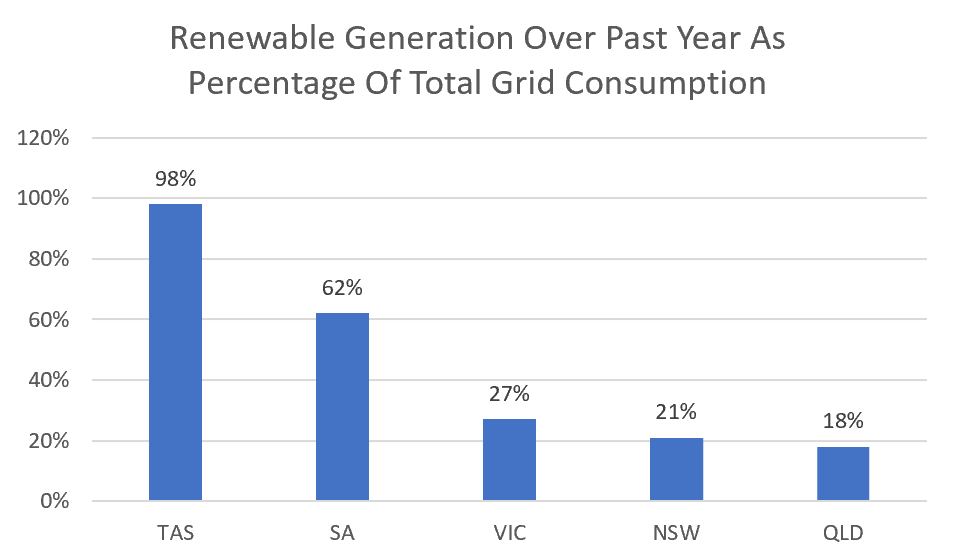
These figures are taken from OpenNEM. When I worked it out, I got 63% for SA rather than their 62%, but my figure included clean energy imports from Victoria. When comparing states, it makes sense not to include clean imports to avoid doubling counting.
As the graphs show, Tasmania and South Australia are way ahead.
Here’s a graph showing wholesale electricity prices in each of these states over the past five financial years:
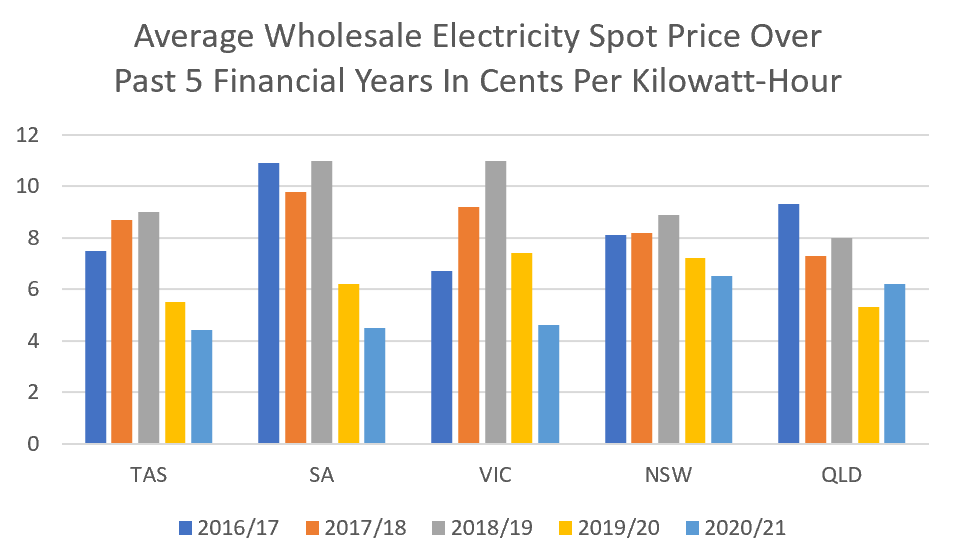
Average wholesale electricity prices are from the AEMO.
In Victoria, wholesale prices show a rise followed by a fall. This was mostly due to the unexpected closure of Hazelwood Power Station in March 2017 with only five months warning3. Victoria normally has low wholesale electricity prices, so the decrease over the past few years has, to a large extent, been a return to normal as new renewable generation and energy storage — along with reduced demand — has lowered prices.
Renewables Pushing Down Prices
While it has been most obvious in South Australia and Tasmania, clean energy has lowered the cost of electricity across the country. Wind and solar energy generation push down prices because:
- It is now cheaper to build a combination of solar, wind, and energy storage than to build new coal and natural gas power plants.
- Wind and solar power have running costs close to zero, and their fuel is free. This makes it profitable for them to continue producing electricity even if they can only sell it for a fraction of a cent per kilowatt-hour. On the other hand, coal and gas generators want to shut down — if possible — when their running costs, including fuel, are higher than wholesale electricity prices.
- Because wind and solar energy output depends on how much light and wind there is, their generation can be high when electricity demand is low. This can result in long periods of low wholesale electricity prices.
Because hydroelectric power is dispatchable and can be switched on and off at will, it’s normally used like gas generation and supplies power when electricity prices are high and shuts down when they are low. But when there’s plenty of rain, they can enter a “use it or lose it” situation and push down wholesale prices in a way similar to solar and wind. This rarely happens on the mainland, but sometimes occurs in Tasmania.
This graph shows renewable energy generation by source as a percentage of each eastern state’s total consumption:
All the suitable locations for conventional hydroelectricity have been used in Australia. There are no remotely economically sensible remaining sites. This means no state can increase its hydroelectric capacity to become like Tasmania, but they can and will increase their wind and solar power capacity to become more like South Australia. This means they will all have large amounts of non-dispatchable generation.
SA Leads The Way
South Australia’s renewable generation is two-thirds wind and one-third solar power, with 75% of its solar energy generation coming from rooftops. It has the most non-hydro renewable capacity because it used to have the highest wholesale electricity prices in the nation.
If you wanted to build a wind farm in Australia, the state with the highest wholesale electricity prices and plenty of wind is the obvious place to start. People are also more inclined to install rooftop solar panels when living in a sunny state with high electricity prices.
The reason why SA wholesale prices used to be high was:
- a lack of conveniently located coal deposits
- moderate electricity demand
Now the state is benefiting from building out its renewable energy capacity.
Other states are following and expanding their solar and wind generation.
No Baseload Generators = No Problem
Many people — mostly idiots — have a bee in their bonnet about baseload power. Their concern appears to be inversely proportional to how well they understand what they’re talking about.
Baseload power is simply the lowest power a grid supplies to homes and businesses over a 24 hour period. It used to always occur in the early morning hours before sunrise, but now it often occurs in the middle of the day thanks to rooftop solar.
Baseload generators are those that operate as close to 24/7 as maintenance and breakdowns allow.
Australia’s baseload generators are coal power stations. Fossil fools who support coal power often claim baseload generators are required to provide stability to the grid. Except instead of baseload generators, they usually say “baseload power” or just “baseload”, which isn’t what they’re actually talking about.
They claim baseload generators are necessary for the grid to reliably operate and for heavy industries such as aluminium smelting, but South Australia shows this is obviously untrue as the state has no non-stop baseload generators. It trades electricity with Victoria — a state with coal baseload generators — but does not import electricity 24/7. SA is happy to spend days either importing nothing or next to nothing.
Baseload generators also aren’t required for heavy industry. Suppose someone wanted to open a new aluminium smelter4, then South Australia would have been the cheapest mainland location in terms of wholesale electricity spot prices for the past two financial years. What heavy industry actually pays for electricity is usually determined by long term contracts rather than wholesale electricity spot prices, but South Australia is now in the running to provide these at the lowest cost outside of Tasmania.
Australia Will Be A Low Wholesale Electricity Price Nation
In the 20th century, Australia had some of the lowest generation costs in the world on account of cheap coal combined with a reckless disregard for the nation’s and planet’s health.
These days of low wholesale electricity prices are on the way back without the death and destruction. As other states put more solar panels on roofs and in solar farms, and construct more wind farms, their average wholesale electricity prices will head into permanently low territory as well.
There’s no guarantee South Australia will keep its first-place position for the lowest average wholesale electricity prices on the mainland. Other states may be able to beat it as coal is driven from the market and they increase the rate renewable energy capacity is built. But each time a coal power station is shut, there will be a spike in wholesale electricity prices until enough new clean generating capacity and energy storage is built to compensate. South Australia got rid of its coal generation years ago and that is going to help.
Australia’s excellent solar and wind resources give us an advantage over most countries, but perhaps we shouldn’t get too excited over that, as no one gave a toss about our low generation costs last century. The only real difference it made was we got a few aluminium smelters. But considering we live in an age where electricity interconnectors can be run between continents, it may amount to more of an advantage this time around.
Footnotes
- Note wholesale electricity prices are only a small portion of residential electricity bills. Because the other components of electricity bills remain high in SA, electricity prices are still high there. But — and this is the point — they’re lower than they were. ↩
- This doesn’t include off-grid generation by agriculture or mining, but note the amount of renewable energy used off-grid is growing fast. ↩
- Hazelwood Power Station was in such poor shape it became too dangerous to operate. That’s too dangerous for people working there. The people in charge of coal generators can be pretty good at ignoring terrible consequences, but even they can’t ignore the increased danger of dying at work. ↩
- The NSW Tomago aluminium smelter — Australia’s largest single electricity consumer — says it plans to switch to all-renewable electricity by 2029. This isn’t the same as running an aluminium smelter in a grid without baseload generators — at the moment NSW officially plans to keep coal power for decades — but it is a good sign. ↩

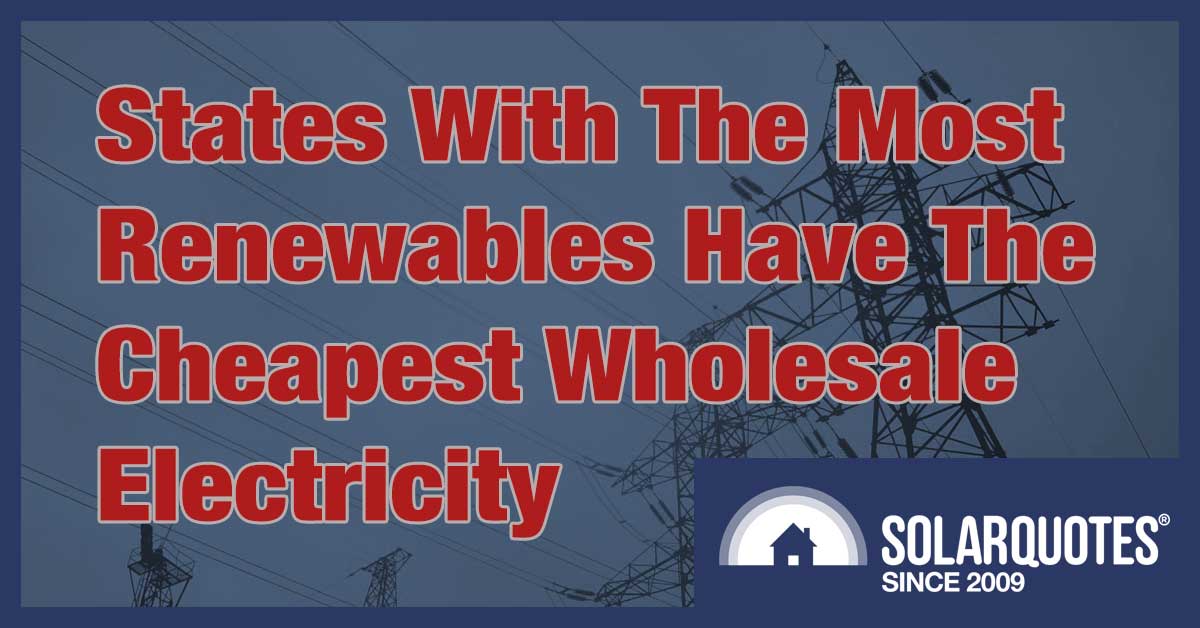
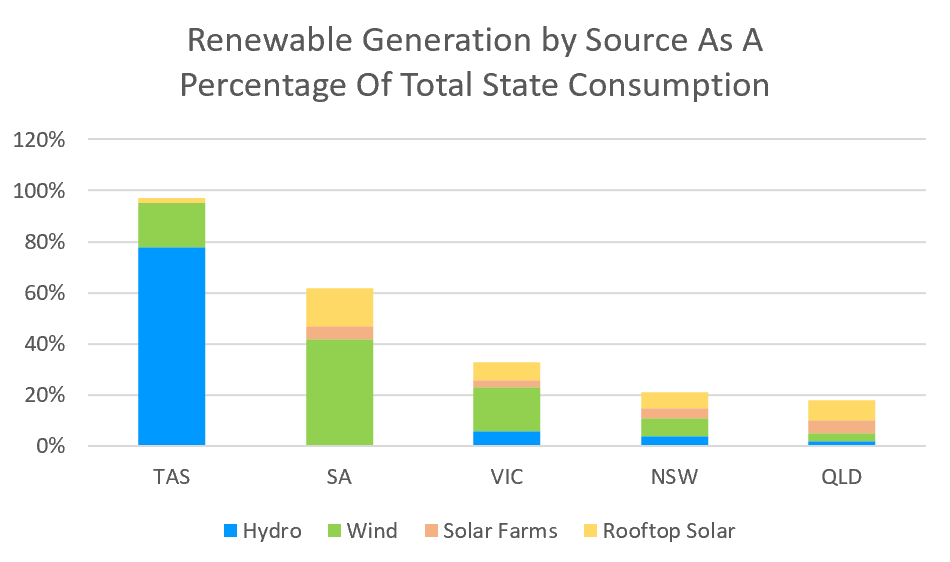
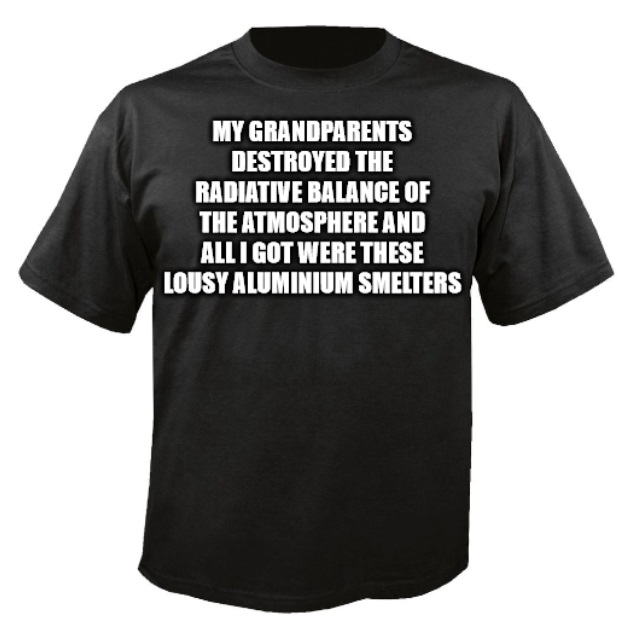
 RSS - Posts
RSS - Posts



Can you please include WA
I’m afraid WA wholesale electricity prices are a bit of a secret. They have what they call the balancing price. According to the rough figures I had for WA from before the pandemic, payments to generators in WA were the highest in the country.
Somewhere there in the fine print you actually mention that which affects us in the real world…Retail prices ..They are not going down and distribution costs at least in Victoria, have just gone up..In response to power wholesale prices dropping feed in Tariffs dropped too…All proof that regardless of the source of power this grubby industry will continue to gouge consumers because they can!
SWIS (power in WA) is now included in OpenNEM
https://opennem.org.au/energy/wem/?range=7d&interval=30m
Thanks for mentioning that. I see WA got 12.7% of their electricity consumption from rooftop solar over the past year.
Surprised to see VIC contributes so little to renewables from your chart, with the majority seemingly from wind. Depends where you live in the state I suppose but I am seeing almost every other house with rooftop solar in my area and am yet to see a windmill. I guess this means we have mostly too small systems at present and still rely on the grid somewhat probably caused by lack of roof space. It seems we desperately need success in producing higher output panels for a given size to overcome this.
Currently 22% of Victorian homes have rooftop solar, which is just over half the rate in QLD and SA. Also, while solar output in Victoria isn’t terrible, it is the lowest on the mainland. While it will take time, I see no reason why Victoria won’t reach OLD and SA levels of installation. New systems are, on average, considerably larger then they were just a few years ago, so by the time VIC gets to Queensland’s 40% figure the average VIC system may be producing considerably more energy than the average QLD one does now.
Brown coal represented 69% of Victoria’s electricity grid energy generation over financial year 2020/21. That’s down from 92% of generation 10 years ago.
Ronald,
What do you say about the claim of “the sun go down” and “the wind doesn’t always blow”?
Also the claim that “energy storage” is also not good for the environment?
Thanks.
1. It sure does.
2. Yep.
3. Compared to what? Burning coal?
No baseload Power, no problem.
I feel this was not fully explained, You stated baseload is not needed and coal is bad, but not how this is achieved.
When is SA relying on other states to supply electricity? i am assuming it is after then sun has gone down.
What happens if all the other states also had the same renewable percentage as SA has now? Would they not all be wanting to import electricity at the same time?
I feel we are close, if i had a tesla battery i could do it as a single household level, but is that an option on a state/country level yet?
James Silcock,
Have you forgotten my comments to you in March?
https://www.solarquotes.com.au/blog/snowy-2-vs-battery-storage/#comment-1027216
https://www.solarquotes.com.au/blog/snowy-2-vs-battery-storage/#comment-1027745
At the moment, South Australia mainly uses gas generation when wind and solar aren’t enough to meet demand. But an increasing amount of battery storage is being used, with a large amount of that located in people’s homes and businesses. It’s now cheaper to build battery storage and charge it with renewable energy than to build new gas load following power stations. So we’re not just close, we’ve basically arrived, but it will take time to replace existing fossil fuel capacity. Fortunately, the costs of both renewable generation and energy storage are still falling, so we’re not going to lose impetus.
While hydro is treated in this piece as renewable power, it isn’t consider green power – see Bob Brown etc. Thus while Tasmania easily leads the pack in terms of renewable energy, that lead is somewhat deceptive.
As for running out suitable locations for hydro, is it that we’re out of locations, or that we’re out of politically\environmentally acceptable locations? Those are quite different things! I recall one farmer who managed to get approval to build a dam on his property for water storage – and he could perhaps have done a small scale hydro thing if he’d wanted to, but extreme green regulations these days mean it would be impossible for other farmers to do likewise. How many other suitable locations are precluded because of political or environmental considerations?
Note too that government penchant for tardy reactivity rather than proactive planning and development exacerbates the issue – something most will probably agree is a problem even if not solar skeptics. : )
I don’t care what people think about existing hydroelectricity. It’s there and it’s going to be used and that will result in basically no emissions compared to using coal or natural gas.
Due to the falling costs of solar and wind generation and battery storage there are no places left in Australia where conventional hydro makes economic sense. I’m not including small scale hydro projects in that or improving or repowering existing hydro.
https://www.anu.edu.au/news/all-news/anu-finds-22000-potential-pumped-hydro-sites-in-australia
There are plenty of potential pumped hydro sites but that’s not conventional hydropower, which is a source of energy rather than a store. Despite there being plenty of sites where it could be built, the economics of pumped storage aren’t looking good thanks to the falling cost of renewable generation and battery storage. It’s looking cheaper to build “extra” solar and wind generation and curtail a considerable amount than to construct pumped hydro with large amounts of energy storage.
Ronald Brakels,
You state: “It’s looking cheaper to build “extra” solar and wind generation and curtail a considerable amount than to construct pumped hydro with large amounts of energy storage.”
The competing tradeoffs I see are generation overbuild/’spillage’ vs interconnector capacity vs energy storage capacity (ranging from multi-hour thru to multi-day) vs demand management. Where’s the ‘sweet spot’?
Can you please link to any recent credible studies/analyses that support your statement? How much “extra” generation?
Looking up studies sounds like work. Rather than do that, I’ll just point out that when 10% of Australian cars are electric, if they average 50 kilowatt-hours of energy storage each, that’s 100 gigawatt-hours of storage. That clearly will reduce the return from future pumped hydro projects. But if someone thinks pumped hydro is worth the investment, good luck to them.
Ronald,
You state: “Looking up studies sounds like work.”
Indeed. ? It suggests to me you didn’t have any evidence/data in mind to support your previous statement.
I wonder how much benefit vehicle-to-grid (V2G) systems can offer. It requires substantial numbers of vehicles to be regularly plugged-in (and therefore not available to drive and/or reduced available range – an inconvenience that some may consider unacceptable) for significant periods of time, and if not done judiciously, the increased charge-discharge cycling could potentially degrade the vehicle batteries sooner.
https://cleantechnica.com/2021/06/22/is-vehicle-to-grid-v2g-tech-the-answer-to-grid-problems/
Perhaps if Tesla can achieve the promised “million mile batteries”, then perhaps battery degradation may be less of a concern.
https://thedriven.io/2020/05/20/teslas-switch-on-vehicle-to-grid-technology-is-big-news-for-clean-energy-shift/
V2G requires favourable standards/regulations/certifications to enable large-scale adoption. Can governments get this done right?
The devil is in the detail. That requires competent and realistic scenario modelling with sensitivity analysis – that seems like work. ?
Ronald I totally agree with your view of pumped hydro with Snowy 2.0 possibly the worst waste of money in our history. Horrible location for use of renewables without mass expenditure on transmission. Like it ruddy impossible to install wind turbines or large scale solar in those mountain forests. There are so many sites in this great continent equivalent to Qld’s Kidston that could all be developed for the billions this single white elephant will cost.
I would be interested in seeing a state by state comparison of median retail pricing for c/KWhr’s rather than wholesale, as those latter figures may not necessarily relate proportionally to the bill I pay every quarter – and the end-user pricing could also more likely incorporate the real costs due to regular import/export via interstate connectors.
When I installed solar PV 11 years ago, I immediately started getting a negative bill every quarter (ie cash back), which was great, but for quite some years now I have had to again pay additional on every invoice because the connection and retail c/KWhr charges have really surged over the intervening years.
Would there be a link to a comparison table showing this data?
I don’t know of any tables with median data – although it wouldn’t be hard for us to do that every so often because we have all the data in our database for this tool – updated a[pproximately weekly:
https://www.solarquotes.com.au/energy/
Soon we’ll be updating this to handle ToU tariffs – which adds another complication – and probably renders median prices as less useful.